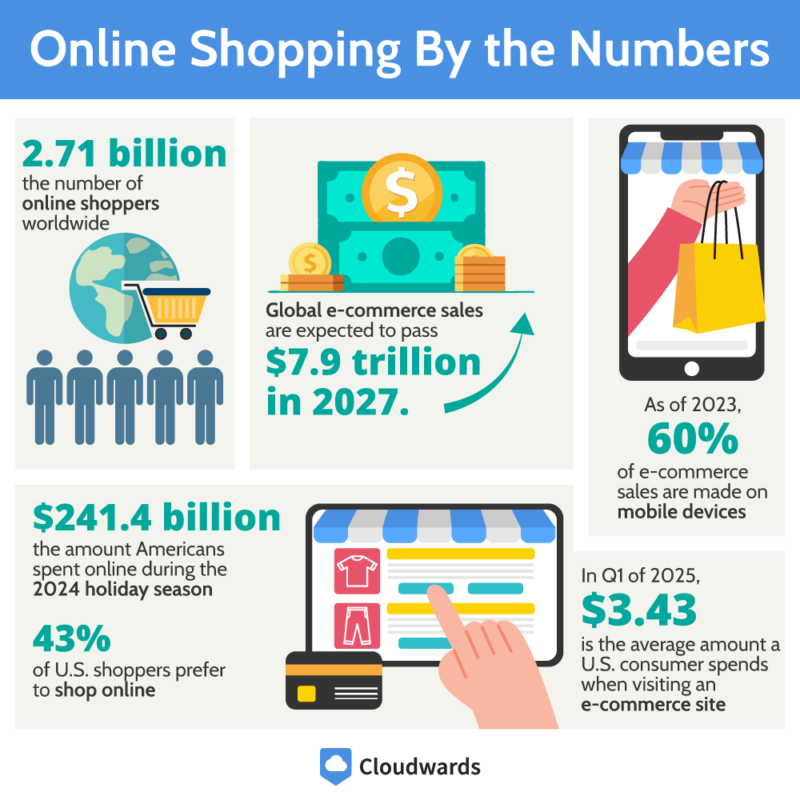Online Shopping Statistics & Trends in 2025
Between advertisements for e-commerce stores to the number of online marketplaces, it’s pretty hard to be an internet user and not notice that online shopping has exploded. If you’re wondering just how big it’s become, read on to discover 24 online shopping statistics and trends.

Given that the internet is one of the fastest and cheapest ways to send information long distances, it’s no surprise that people made retail websites to take advantage of this new technology. However, you can only see how far it has come by looking at some online shopping statistics.
The e-commerce industry and online shopping effectively cover all purchases that are made over the internet. Between stores moving online, third-party marketplaces and increasing internet access across the world, these online sales have become worth trillions each year.1
Stores have always tracked sales data, where their revenue comes from, and customer trends, so it makes sense that companies also watch similar e-commerce trends now that they’re worth so much. Luckily, many of these statistics are available for free, so we’ve collected 24 of the most interesting ones here.
-
02/16/2022 Facts checked by Eugenie TiuSources verified.
Updated article statistics to ensure all of the information was up-to-date.
-
04/11/2025 Facts checked
We refreshed the statistics to make sure they’re up to date and added new stats that reflect developments in the e-commerce world.
24 Online Shopping Statistics

When you’re online, companies are constantly collecting data about you — you can read up on some data privacy statistics to find out more about this. Obviously, this isn’t great for individual privacy, but it does mean that there are plenty of interesting statistics to go through, so we’ll jump straight in to look at how e-commerce has grown and how much it might grow in the future.
Online Shopping Statistics: The Scale of Online Shopping

Without a doubt, online shopping is widespread and pretty big, so these first six statistics will go into the true scale of how many people are online and how much money is spent on these sites.
1. How Big Is Online Shopping?
With annual retail e-commerce sales passing an estimated $6.3 trillion worldwide in 2024 (based on early 2024 predictions), online shopping is bigger than the GDP of Germany (approximately $5.7 trillion in 2025).1
2. How Many People Are Shopping Online?
As of 2024, there are 2.71 billion online shoppers around the world. In 2025, the number is forecast to surpass 3 billion.2
Taking into consideration that only 63% of the world population has access to the internet, that means just under half the world population with an internet connection use it to shop online.3
3. How Big Is Online Shopping in the U.S.?
E-commerce revenue in the U.S. was more than $1.1 trillion in 2024. The number is expected to grow to more than $1.3 trillion in 2025.5
Various strands of e-commerce worldwide are experiencing growth — the subscription e-commerce market is an example. Globally, this market is expected to grow to over $539 billion in 2025, up from around $326 billion in 2024.28
4. How Much Will Online Shopping Grow?
eMarketer predicts that e-commerce sales will grow to surpass $7.9 trillion by the end of 2027. That’s more than the GDP of Japan (approximately $6.3 trillion in 2025).1
As for payment methods, digital wallets are on the rise. The use of digital wallets like PayPal and Apple Pay to make payments is predicted to have reached 61% of global e-commerce sales by 2027.29
5. How Many Americans Are Shopping Online?
More than three quarters of consumers in the United States have shopped online. It has been predicted that sales from retail e-commerce will see a 9% growth rate between 2024 and 2029.12
6. How Often Are Americans Online?
In 2024, a Pew Research Center report revealed that 90% of American adults are daily internet users, with 41% reporting being online “almost constantly.” The remaining 10% is made up of people who say they use the internet “less than daily” or not at all.20
Although having internet access doesn’t guarantee they’ll use online stores, if you want to buy something online, you have to use the internet. This means that most Americans have the potential to become online shoppers at some point.
Shopping Online vs in-Store Statistics

Although online shopping seems to be the future, these next statistics show that many people still like going into a store to see physical goods.
7. How Often Do People Shop Online?
In 2021, the IPC surveyed people across 40 countries and found that most people shopped online once every two weeks (27%) or once a month (29%) — only 22% of respondents shopped online every week.18
This IPC survey also found that 74% of people thought that more of their domestic purchases would be done online in the future. In contrast, only 5% thought that this would go down.
8. Do People Prefer to Shop in-Store?
A 2018 Marist Poll study found that 56% of Americans prefer shopping in a physical store than online, if everything is equal. However, being able to shop at any time (64%), to find the item easily (62%) and to save time (61%) were all major reasons that could lead to people choosing to shop online.4
For comparison, early 2023 data shows that around 43% in the U.S. prefer to shop online. This means the number of people preferring to shop in-store (57%) hasn’t changed much since 2018.31
9. How Does E-Commerce Compare to Traditional Sales?
A census by the U.S. Department of Commerce found that in the third quarter of 2021, online retailers made up 12.4% of total retail sales in terms of value, or 13% when accounting for seasonal variations.7
For comparison purposes, a 2025 United States Census report explains that e-commerce sales in quarter four of 2024 totalled 17.9% (not adjusted for seasonal variations) or 16.4% (not adjusted). Note that the adjusted figure does not account for price changes.21
Special Online Shopping: Pandemic & Holiday Season

There are certain events that cause a spike in shopping, in-general: the holiday season, as well as the Covid-19 pandemic. Here are some statistics related to these shopping events.
10. How Much Does Shopping Increase in the Holiday Season?
According to a 2024 seasonal holiday shopping report by Adobe, November and December saw Americans spend $241.4 billion online — a total of 8.7% more than in 2023. This is a record-breaking figure according to Adobe.15
11. How Big Is Black Friday & Cyber Monday For Online Shopping?
In 2024, Black Friday saw $10.8 billion and Cyber Monday saw $13.3 billion in total U.S. sales. From 2023 to 2024, revenue for both days increased by $1 billion for Black Friday and almost the same amount for Cyber Monday.
With a jump from $5.6 billion to $6.1 billion, Thanksgiving also saw positive growth in 2024, as did Veteran’s Day (from $3.1 billion to $3.3 billion).15
12. How Covid-19 Affected Shopping
Between the second quarter of 2020 and the first quarter of 2021, e-commerce saw growth of between 32% and 43.8% — over double what would normally be expected. This calmed down to a modest 9.1% growth between the second quarter of 2020 and 2021, but it still represents a lasting change boosting e-commerce over physical stores. 17
Due to the WHO classifying Covid-19 as a pandemic in March and the subsequent lockdowns and stay at home orders that came out, the first quarter of 2020 was mostly normal for online shopping. The U.S. Department of Commerce found just 14% growth between the first quarters of 2019 and 2020 — similar to the average growth of 14.1% between each quarter of 2018 and 2019.
Online Shopping Statistics: Cart Abandonment

It’s easy to leave a website and abandon your cart, and these statistics show how common it is and why people do it.
13. How Common Is Cart Abandonment?
Baymard looked at various articles, and found an average cart abandonment rate just shy of 70%. However, many studies have been done on cart abandonment and they often yield widely different results depending on when they were run and the populations they looked at.8
14. Why Do People Abandon Online Carts?
The Baymard study, updated in 2025, also looked at the reasons U.S. adults abandoned their carts during checkout. At 39%, shipping, tax and other extra costs being too high is the top reason followed by discovering delivery would take too long (21%).8
This study also found that not trusting the site enough to enter credit card details and not wanting to create an account, at 19% each, also contribute to cart abandonment rates.
Online Shopping Statistics: The Impact of Third-Party Marketplaces

Some of the largest and most well-known sites are marketplaces where other companies can sell their goods. These next statistics look at how big these marketplaces can get and which ones are the most popular.
15. How Important Are Third-Party Marketplaces?
The 2021 online marketplace report by Digital Commerce found that sales on the top 100 platforms accounted for 62.7% of the money spent online in 2020, which is slightly higher than the 60.1% in the year before.9
When looking for goods online, it’s often easier to go through an e-commerce market. These are sites that other companies can use to sell their products and online shoppers can use to search for and compare different options.
16. What’s the Most Popular Online Marketplace?
Amazon earns the most annually — $638 billion to be precise — and receives the most monthly visits and search traffic. 79% of Amazon searches are from the U.S. eBay follows Amazon in the number of monthly visits and search traffic.22
17. How Many People Are Using Online Marketplaces?
In 2024, it was reported that 30.9% of consumers shopping online used a marketplace like Amazon or eBay a few times monthly, based on a survey of 1,017 participants. 20.16% reported using these sites to make purchases a few times weekly while 13.86% use them once a week.23
U.S. Consumers Who Used a Marketplace for Online Shopping
How Online Shoppers Use Different Devices

Shopping on your phone is often just as easy as on a desktop, and these statistics show how common it is to use different devices and how people shop differently on each device.
18. What Is the Average Order Value?
In the first quarter of 2025, Salesforce found that on an average visit to an e-commerce site, American shoppers spend $3.43. This is significantly higher than the global average, which was just $2.42 per visit.
The average value per order in the U.S. in the first quarter of 2025 was $134.97. This is still above the average of the countries studied, which was $112.14.10
19. How Do Other Devices Compare to Desktop Orders?
Salesforce found that, globally, computer orders made up only 22% of traffic and 30% of orders in the first quarter of 2025. At the same time, mobile orders made up 68% of order shares and 77% of traffic to e-commerce sites.10
20. How Many People Use a Smartphone for Shopping?
A 2023 survey by the PwC found that 34% of consumers used smartphones to shop over the previous 12 months compared to 43% shopped in-store.24
2023 data from PwC also revealed more than half of shoppers use their mobile devices to check out products before purchase (56%) and read reviews (54%) on sources like retailer websites, Amazon and social media and more.
Meanwhile, four in ten look up information about products on their mobile devices while physically in a shop.19
Moreover, many are interested in augmented reality experiences, commonly delivered via smartphones, when shopping. At least 90% of American consumers use augmented reality when shopping, or would consider using it.30
21. How Many Sales Are Made on Smartphones?
As of 2023, mobile e-commerce sales account for 60% of global e-commerce sales based on data from Statista. In 2023, mobile sales reached $2.2 trillion and it’s expected this number will rise to 3,436 in 2027.25
The Importance of Reviews and Social Media in Online Shopping

Most online shops have some kind of review system and some social media sites are even large enough to become shops. These statistics show just how much other people’s opinions and reviews affect our purchases.
22. Are Reviews Important?
According to a 2021 Bizrate survey on customer reviews, only 8.7% of online shoppers will typically buy something without reading any reviews. On the other hand, more than half of respondents said they will read at least four reviews before making a purchase.11
However, while most consumers will only read a handful of reviews, 38% said they would only trust something with over 50 reviews. Just 12.9% of respondents said the number of reviews didn’t matter.11
23. Are Sponsored Reviews Important?
The Bizrate survey also found that only 32.7% didn’t trust sponsored reviews. This means that, depending on the specific influencer and review, 67.3% of people had at least some trust in products after a sponsor review. However, as only 6.1% said they completely trust these reviews, they’re often better for increasing awareness for new customers.11
Percentage of Shoppers That Trust Online Reviews
24. How Often Do People Buy From Social Media?
The social commerce market continues to thrive. In 2023, Mintel Group discovered that almost half of U.S. consumers (47%) have bought something on a social media platform. 39% said they would buy something via social media again.26
Of the major social networks, Facebook was the most popular — 75% reported having purchased something on the platform. However, the dedicated Facebook Marketplace is also likely to have caused this.
What’s more, live commerce is gaining traction. In 2023, Coresight Research found that the live commerce market is worth more than $5 billion.27
Final Thoughts: Online Shopping Statistics
E-commerce is a big industry, and it’s not going away anytime soon. Hopefully these online shopping statistics have made it easier to grasp consumer acceptance of online shopping and what’s important to customers.
If these kinds of facts and statistics articles interest you, check out our articles on cloud computing statistics, online gaming statistics and VPN statistics to learn more about these complex aspects of the internet.
Have you bought anything from an online store before? Did any of these statistics interest you? Were there any facts we missed? Let us know your thoughts in the comments below. Thanks for reading.
FAQ
A PWC survey from 2023 revealed that 34% of participants used smartphones to shop over a 12-month period while 23% used PCs. 15% used tablets. By comparison, 43% shopped in-store. 24
Around 2.71 billion shop online as of 2024. E-commerce sales hit $6.3 trillion worldwide in the same year. 2,1
As of 2024, 2.71 billion shop online.2 There are around 8.2 billion people in the world, meaning around 33% of the global population shops online.
Sources:
- eMarketer – WorldWide Retail Ecommerce Forecast 2024
- eMarketer – There Will be More Than 3 Million Digital Buyers Worldwide in 2025
- Our World in Data – Internet
- Marist Poll – Digital Economy Poll
- Statista – Revenue of the e-Commerce Industry in the U.S. 2019-2029
- BigCommerce – Consumer spending trends 2021
- U.S. Census – Quarterly retail e-commerce sales
- Baymard – Cart abandonment rates
- Digital Commerce – Online marketplace report 2021
- Salesforce – Shopping Index
- Bizrate – Shopper Survey Report
- Statista – Online Shopping Behavior in the United States
- Statista – E-commerce statistics
- Data Reportal – 2022 Global Report
- Adobe – 2024 Seasonal Retail Trends
- U.S. Census – Adjusted e-commerce sales over time
- eMarketer – Global e-commerce forcast
- IPC – Cross border shopper survey 2021
- PwC – Consumer insights survey June 2023
- Pew Research Center – Americans’ Use of Mobile Technology and Home Broadband
- United States Census Bureau – Quarterly Retail E-Commerce Sales
- Capital One Shopping Research – Most Popular Online Stores
- Digital Commerce 360 – Everyone’s Doing It: Most Consumers Shop Online Marketplaces in 2024
- PWC Global Consumer Insights Pulse Survey February 2023
- Statista – Global eCommerce Worth $2.2 Trillion in 2023
- PR Newswire – Nearly Half of US Consumers Say They Have Made a Purchase Through Social Media
- CNBC – Livestream Shopping Booms as Small Businesses Strike Gold on Social Media
- The Business Research Company – Subscription E-Commerce Global Market Report 2025
- Worldpay – Global Payments Report
- Google Consumer Insights
- Statista – Share of consumers that would prefer to shop mostly online or mostly in-store worldwide in 2023, by country

